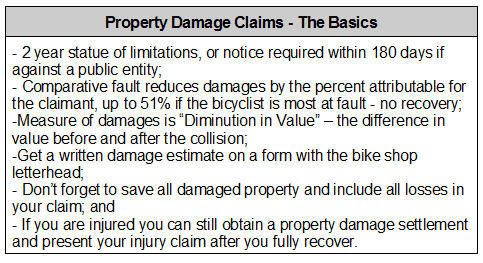I. Introduction
Sometimes it’s tough to get fair treatment when a collision results in property damage but no personal injury. While it’s always better not to have to deal with a physical injury, there is not enough money involved from the contingent fee (1/3) on a property damage case for most lawyers to even justify opening a file, so most riders end up representing themselves. If you are going to go it alone it helps to know the lay of the land before you start. This article contains an overview of the law of property damage and some tips on how to get a fair amount for your damaged ride.
Fortunately, most bicycle collisions do not result in personal injuries. Instead, wheels get bent, helmets scraped and, if the accident is the motorist’s fault, a “property damage” claim is made against an insurance company. For bicyclists, property damage claims can be frustrating because they typically have little or no experience in legal matters and find themselves advocating for damages with experienced claims adjusters. Since the amount involved is usually small, the bicyclist ends up appealing to the claims adjuster’s sense of fairness. Most claims adjusters are not experienced riders and they are frequently shocked by the costs of bicycle repair and parts.
II. Comparative Fault
Since property damages are not recoverable unless the motorist is more than 50 percent at fault, Oregon’s law requires a potential defendant pay their percentage of fault only if it is greater than the bicyclist. This means that if the bicyclist is 51 percent at fault and a motorist is 49 percent at fault, the motorist completely escapes financial
responsibility. But if for example the motorist is 80% at fault, and the bike rider is 20% at fault, the motorist must pay 80% of the damage under Oregon’s “Comparative Fault” law. This means that bicycle riders need to be prepared to show the legal basis for their damage claim, and adjust their damages down by their own percent of contribution to the wreck.
Typical shared fault scenarios include collisions that result from multiple factors, like when a rider fails to exercise “due care” after a motorist makes a driving mistake, such as when a rider panics and crashes after being cut off by a motorist when if the rider had done nothing there would have been no contact or impact.
Since the claims adjuster’s job is to pay as little as possible on a claim, any fault arguably attributable to the bicyclist will be pointed out as a reason to reduce the amount paid. It is essential during these discussions that a bicyclist know the basic Rules of the Road. If possible, be prepared to cite actual Oregon Revised Statute (ORS) numbers.
This article will be concluded in later posts.
Ray Thomas is a founding partner at Swanson, Thomas, Coon & Newton where he represents bicyclists and pedestrians injured in collisions.


Pingback: Accidents that result in property damage (Part 2) by Ray Thomas - OregonBikeLaw.com | OregonBikeLaw.com
Pingback: Accidents that result in property damage (Part 3) by Ray Thomas - OregonBikeLaw.com | OregonBikeLaw.com